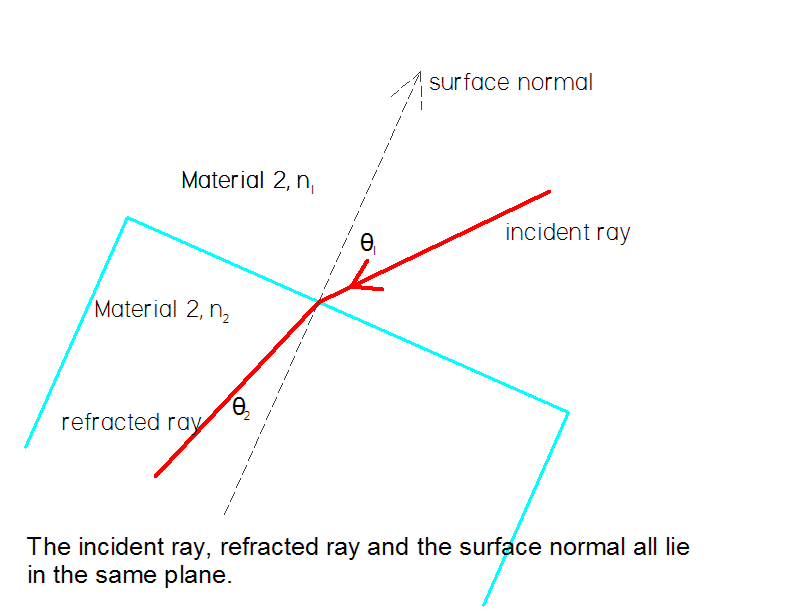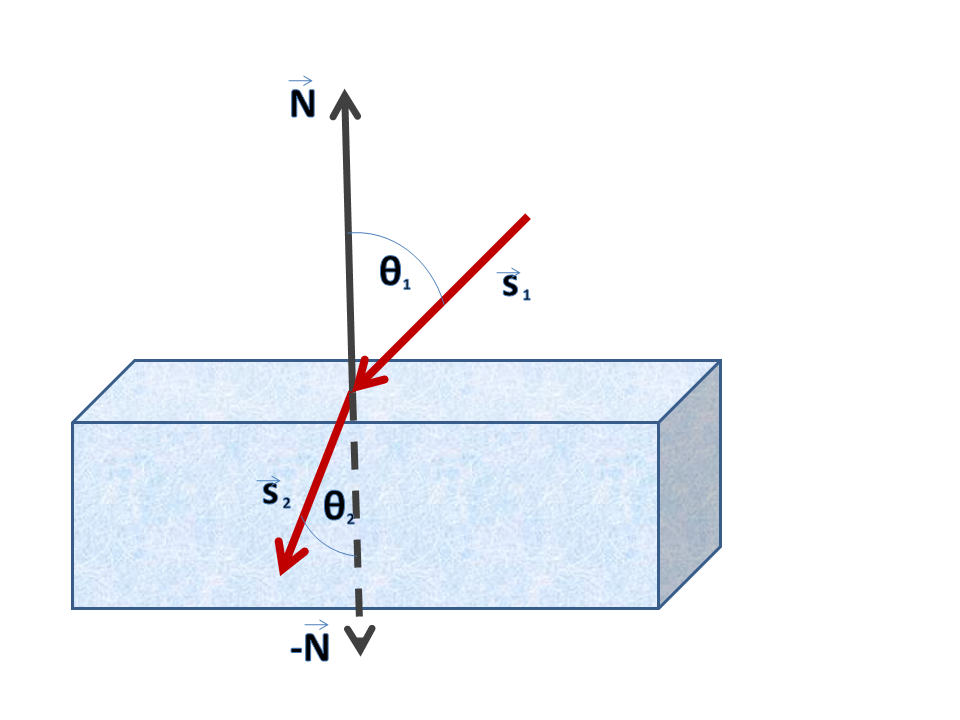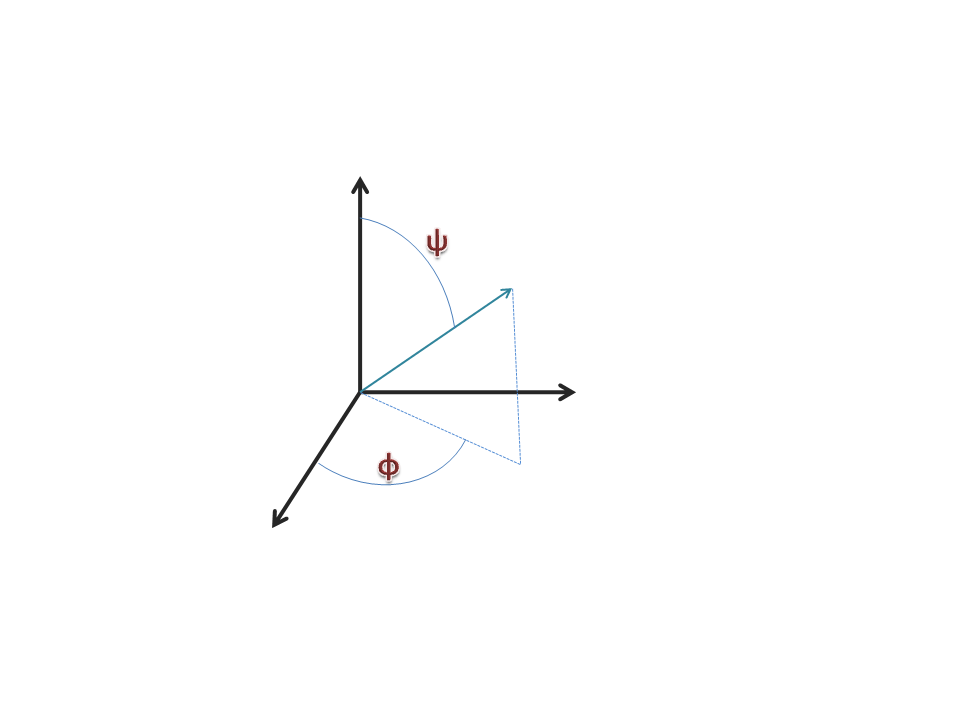Welcome to the StarkEffects.com page on Snell's Law.
One of the very important characteristics of a transparent material is the effect it has on the direction of light that it transmits. A beam of light incident on the interface between two materials, if it is transmitted at all, will be refracted so that the new direction of travel makes some angle with original direction. This is described very succinctly by Snell's law. On this page we will show the vector form of Snell's Law which you may find very useful when writing a computer code for calculating the direction of transmitted light.
Snell's Law in Vector Form
Snell's law describes how to calculate the change of direction of a "light ray" transmitted across a material interface as a function of the geometry of ray and material interface and the characteristics of the material for the wavelength of light being transmitted. Since the incident ray, the refracted ray and the normal to the surface of the material interface where the ray is incident are all in the same plane, Snell's law is usually given in a scalar form and you are left to arrange the geometry yourself to fit the equation.

Well, I wanted to see what Snell's law would look like if I had a given fixed coordinate system that I wanted to keep constant through my calculations, and had an incident ray direction given by a vector in that coordinate system along with a normal to the surface given in the same coordinate system. This vector form of Snell's law is very useful in some of my computer calculations for ray tracing.
Usual Form of Snell's Law
Snell's law is usually presented as:

where n1 and n2 are the indices of refraction of the first material (incident side) and the second material (refracted side) respectively, and the angles of incidence and refraction, θ1 and θ2 are measured between the incident light ray and the surface normal (the vector normal to the surface between the two materials) and the refracted ray and the surface normal on the other side (which is just the negative of the firts normal vector).

Derive a Vector Form for Snell's Law

The equation I've given here shows the unit vector in the direction of the refracted ray as the vector addition of a component along the surface in the plane of incidence and a component along the surface normal. I prefer to work with all of these vectors as unit vectors so, when I use them in a calculation I often use the (x,y,z) components of each vector in normalized fashion and often given in terms of the angles in declination and azimuth in a fixed coordinate system:
where ψ is the angle measured from the z axis to the direction vector and φ is the measure of the angle between the positive x axis and the projection of the vector onto the xy plane of our coordinate system.

I've made use of two important results to write this equation. First is Snell's law in the usual form:  . Second is the cross product:
. Second is the cross product:  , Where
, Where  is a vector perpendicular to both the ray,
is a vector perpendicular to both the ray,  , and the surface normal,
, and the surface normal,  . By combining the identity:
. By combining the identity:  and the scalar form of Snell's law,
and the scalar form of Snell's law,  we can look for the component of the refracted beam along the negative of the surface normal,
we can look for the component of the refracted beam along the negative of the surface normal,  , and add that to the component along the surface itself in the plane of incidence,
, and add that to the component along the surface itself in the plane of incidence,  , to finally arrive at:
, to finally arrive at:

An Example of Using the Vector Form
Let's try a simple example using this vector form:
And now a little less obvious example:
What is the index of refraction
Every material has a characteristic response to electromagnetic radiation. When that E/M radiation is in the optical frequencies, 1014 to 1015 Hz, then an important influence on that response is held by the strength of the bonds on the electrons in the material. Those electrons are set into motion and the resulting electromagneteic field radiated by those oscillating electrons added to the original incident field creates the light beam transmitted through the material. In linear materials that beam has the same frequency as the original beam, but a different wavelength. In transparent linear material the ratio of the wavelength for the same opitcal frequency in vacuum to the wavelength in the material is called the index of refraction: n=λvacuum/λ.
Often the index of refraction is referred to as the ratio of the speed of light to its reduced speed in the medium: n=c/vmedium. Or, we can write the index of refraction as a function of the material's relative electric permittivity, ε , and µ is its relative permeability.

Index of refraction depends on:
Several important factors may have an effect on the index of refraction of any given material:
- Frequency of the incident light
- Temperature
- Direction of transmission with respect to the material
- Polarization of the transmitted light
- An applied static electric field
- An applied static magnetic field
- Pressure
- Mechanical stress
See dispersion, birefringent materials, piezoelectric materials, and non-linear crystals for some of the more interesting dependencies.
Snell's Law and Fermat's Principle
Fermat's principle states that light travels along the path that takes the least time. If you consider the index of refraction as a measure of the speed of light in a material, then you can use Fermat's principle to derive exactly the same angular relationship between incident and refracted beams as Snell's law. The difference here is that instead of beginning with an incident beam in a particular direction, you begin with starting and ending points and derive the lines or rays that will take the least time to travel from the start to the finish point.
Snell's Law and Huygens' Theory
One way to obtain Snell's law is to use Huygens' theory. According to Huygens, each point on an advancing wavefront is a new source of a spherical wave. When you add up all the spherical waves you get the wavefront you are more familiar with. For example, in a plane wave, each point on the plane wavefront is a source and adding up the spherical waves from all of these sources give you a plane wave advanced to the next moment in time.
As the speed of the wave is decreased upon entering into a higher index material, you create a plane wave in a slightly different direction as the waves from points not yet in the material are traveling faster than the waves inside. Rays, in this view, are simply the normal vectors to this composite wavefront.
Who was Snell?
The Dutch astronomer and mathematician, Willebrord Snellius (1580–30 October 1626, Leiden) was born Willebrord Snel van Royen and in 1613, succeeded his father, Rudolph Snel van Royen (1546–1613) as professor of mathematics at the University of Leiden. In the west, Snell's name has been attached to the law of refraction of light for several centuries even though this law was discovered by Ibn Sahl in 984. The same law was also investigated by Ptolemy and Witelo, but their results were saved as tables since no one yet treated trigonometric relationships as functions.
Snellius (Snell to most of us English speakers) was born in Leiden, Netherlands 1580. In 1615 he put into practice a new method of finding the radius of the earth, by determining the distance of one point on its surface from the parallel of latitude of another, by means of triangulation. His work Eratosthenes Batavus ("The Dutch Eratosthenes"), published in 1617, describes the method. His published result was the distance of 117,449 yards between Alkmaar and Bergen op Zoom, two towns separated by one degree of meridian. That result, equivalent to 107.395km, is only 3.2% off from the correct 111km.
He rediscovered the law of refraction in 1621.
Quick Science & Math References
- Our Solar System.
- Earth Facts.
- The Metric System.
- Trigonometric Identities.
- Vector & Tensor Identities.
- Explicit Forms of Vector Operators
- Light & Electromagnetic Spectrum.
- Common Laser Wavelengths.
- Human Physiology Facts.
- Human History Timeline
- Geologic Timeline
- Cambrian Explosion
- Life on Earth Timeline
- ASCII Codes and HTML Display Codes
- Thousands of HTML Symbol Codes
- HTML Symbol Codes for Greek Letters
- The Best Way to put Equations on your Web Page
Physics Basics Series
- Basics of Classical Mechanics.
- Basics of Quantum Mechanics.
- Basics of Electrodynamics.
- Basics of Optics.
- Basics of Mathematical Tools for Physics.
- Basics of Plasma Physics.
- Basics of Solid State Physics.
Math Basics Series
- Numbers
- Arithmetic
- Algebra
- Geometry
- Analysis
Technology Basics Series
- Basics of Remote Sensing.
- Basics of Digital Signal Processing.
- Critical Electronic Circuits
- Infrared Imaging Basics
Knowledge Branches
- Information Theory
- How Reading Works in the Brain
- Psychology of Learning
- Logic
WORK IN PROGRESS
- What is the Stark Effect?
- The Chemistry of Love &/or Addiction
- Critical Thinking: How to question what you see, read or hear.
- Aristotle's Prior Analytics - the birth of Logic.
- Optical Solutions, lenses that solve problems
- Fractals
- PTC - Photon Transfer Curve or Mean Variance Analysis
- 3-D Noise
- Laser Primer
- Rail Guns
- Special Relativity
- Radar Technology
- Acousto-optic Cells
- Harmonic Generation for Laser Frequency Doubling (SHG) and Tripling -using non-linear crystals.
- Measurement: Accuracy & Precision.
- Things you should know about computer modeling of physical phenomena!
- Giant Magneto-resistance
- Peltier Cooling
- Pyro-Electric Detectors
- Piezo-Electric Crystals
- Laser Speckle
- FFT and DFT the fast fourier transform and the discrete fourier transform
- Fabry Perot Etalon
- The Hydrogen Atom.
- PCA (Principal Component Analysis)
- Energy per mass in fuels such as Hydrogen, Gasoline, Kerosene, HMX etc...
- Nobel prize winning work on the CCD
- How does a CCD work and what are the normal characteristics of a CCD
- Nobel Prize Winning work on Giant Magneto-resistance
- FROG -frequency resolved optical gating
- Optical Wavefront Sensing
- THz imaging and time-domain spectroscopy
- Camera Calibration
- Laser Designators
- Resampling
